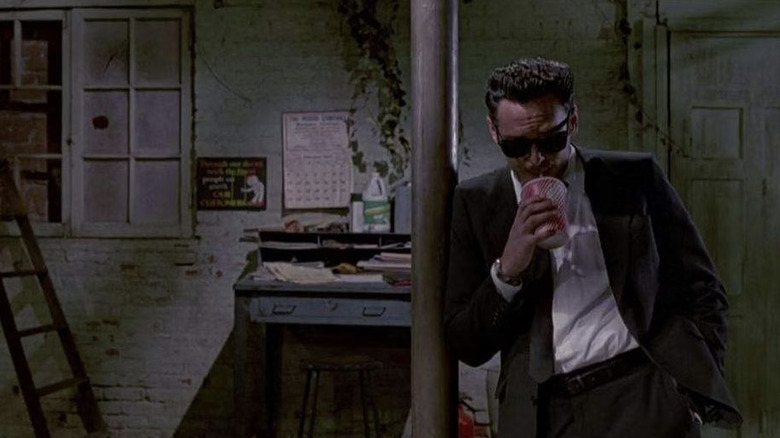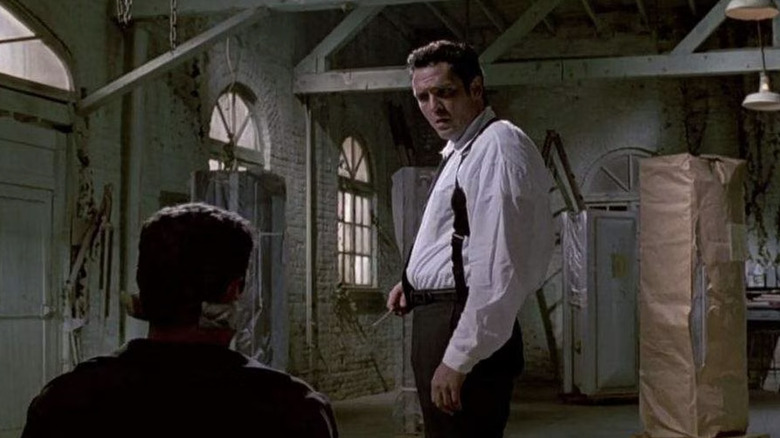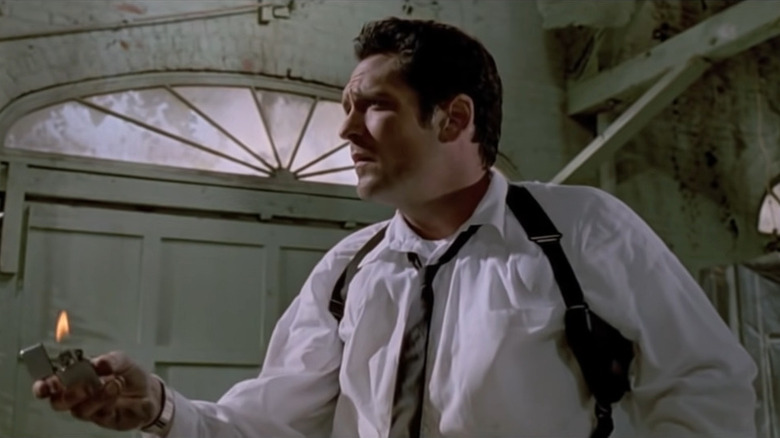The Torture Scene From Quentin Tarantino's Reservoir Dogs Disturbed Horror Greats Like Wes Craven & Rick Baker
"Reservoir Dogs" is an interesting film to revisit, for you can see all the techniques and storytelling devices that would become Quentin Tarantino staples. The soundtrack, nonlinear writing, and excessive blood. However, no one knew what to expect from the filmmaker when "Reservoir Dogs" first came out over three decades ago. The script had confused its fair share of individuals in Hollywood — though it was framed as a crime film, it hardly featured any action or actual robbery for most of its runtime. When I first saw it, I was confused but also allured by its unique structure and story. I was entranced by how Harvey Keitel, Steve Buscemi, and Tim Roth's characters dealt with the bloody aftermath of a heist I didn't even get to see.
From the beginning, audiences are treated to a number of different conversations. Discussions about tipping servers, rats, anonymity, and maniac accomplices. Most of "Reservoir Dogs" takes place in a warehouse, leading you to believe nothing crazier can happen than what's being described by the powerhouse actors on the screen. Then Mr. Blonde (Michael Madsen) arrives with a kidnapped police officer in tow, and things take a gleefully sinister turn that matches his mood. The safety of the characters that you're familiar with by this point, Mr. White (Kietel) and Mr. Pink (Buscemi), leave the film for the torture scene that follows. It's the first real taste of violence from Tarantino — and a jarring transition from all the conversations until then. If Blonde's torture of the police officer disturbed you, you're not alone. A couple of horror icons felt the same way.
Making violence real
In the aforementioned torture scene – set to the tune of Stealers Wheel's 1972 song "Stuck in the Middle with You" — Mr. Blonde cheerfully cuts the tied-up police officer's ear and then pours gasoline on him. Before it gets any darker, a bleeding-out Mr. Orange (whom the audience has virtually forgotten) guns down Blonde, putting an end to the terror. Even looking at the rest of Tarantino's filmography after this, Blonde's torture scene in "Reservoir Dogs" is arguably still one of the most brutal things the director has put on film.
In a 1994 interview with Rolling Stone, Tarantino said he wasn't phased by people walking out of his debut film in reaction to the scene. In fact, he believed such acts gave credence to the authenticity of what he created: "It never bothered me when people walked out; it just meant that scene worked. Go to a video store, and nine out of 10 films in the action-adventure section are more graphic than mine. But I'm not interested in making a cartoon. I'm interested in making the violence real."
Tarantino wasn't just speaking in generalities regarding people walking out of his movie. The filmmaker would specifically recall the screening of "Reservoir Dogs" at a horror festival in Spain, where some big names in the horror industry saw his film for the first time and reacted adversely to the bloodthirsty antics of Mr. Blonde:
"So we show the movie, and, like, 15 people walk out during the torture, including [cult horror director] Wes Craven and [horror special-effects artist] Rick Baker. Wes Craven — the guy who directed 'Last House on the Left,' for God's sakes — walked out of my movie."
'Take it as a compliment'
But why would Wes Craven and Rick Baker, masters of horror in their respective crafts, be disturbed by the violence in "Reservoir Dogs"? If you take a closer look at their work, it makes sense. While Craven has left his mark with realism in horror with "The Last House on the Left," most of his filmography has been satirical as with "Scream," or fantastical and supernatural as in "A Nightmare on Elm Street." Rick Baker also brought larger-than-life horror icons to the big screen with impressive makeup work, but it's all created at a safe distance from reality.
As Baker would best explain when he spoke to Quentin Tarantino after "Reservoir Dogs," walking out during the torture scene was a testament to its effectiveness. While Baker — and, to some extent, Craven — enjoyed crafting horrific tales, they were usually out of the realm of possibility:
"Quentin, I walked out of your movie, but I want you to take it as a compliment. See, we all deal in fantasy. There's no such thing as werewolves or vampires. You're dealing with real-life violence, and I can't deal with it."
"Reservoir Dogs" moves on from the violent scene pretty fast with the reveal of Mr. Orange as the rat, but the movie will always be known for Mr. Blonde's bloody dance number. The cruel and dark act felt dangerously real — and is just one of many reasons Tarantino is such an effective storyteller.


